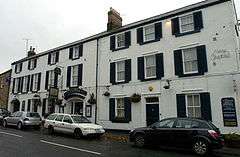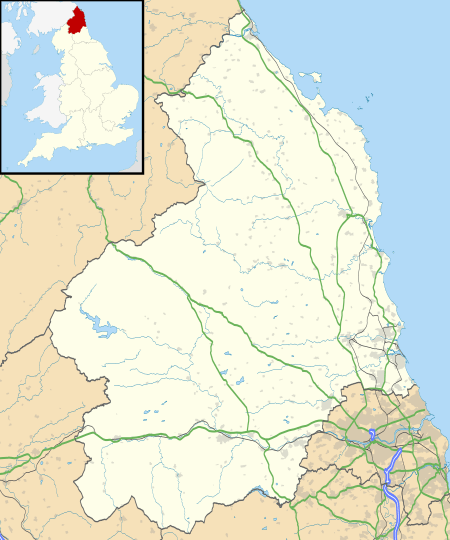Schooner Hotel
The Schooner Hotel & Bar is a Grade II listed 17th century coaching inn and hotel located at 8 Northumberland Street in the coastal village of Alnmouth, Northumberland, England.[1] The hotel lies on the main High Street and is recognizable by its whitewashed walls and black painted shutters.[2][3] In the 19th century the 32-room hotel had a considerable reputation with a clientele of people such as Charles Dickens, John Wesley, Basil Rathbone, and King George III of England.[4]
| Schooner Hotel | |
|---|---|
 | |
 | |
| General information | |
| Location | 8 Northumberland Street, Alnmouth, Northumberland, England |
| Coordinates | 55°23′14″N 1°36′44″W |
| Inaugurated | 17th century |
| Owner | John Orde |
| Website | |
| Official website | |
Architecture
The Schooner Hotel became a Grade II listed building on 31 December 1969.[5] It is a whitewashed building with black shutters, originally built in the 17th century. It was extended in the early 19th century and again towards the end of the 19th century.[5] It is built from tooled squared stone, three storeys high (excluding the cellar), and has 5 + 3 bays.[5] The older section on the left has half-glazed doors with from the 20th century with an old segmental-headed arch at right end.[5] The roof is made from Welsh slate roof, with 2 chimney stacks rebuilt in yellow brick.[5] In the 2010s the rear portion of the hotel was renovated and turned into six separate properties; 3 apartments and 3 townhouses.[6] The land behind the hotel that used to contain the Alnmouth Squash Courts is scheduled for further development into 7 houses.[7] The first request for 8 houses was rejected due to insufficient information about contaminated land and archaeology.[8] The second application was approved.[9][10]
Haunting
Sixty individual apparitions and more than 3,000 sightings have been recorded, making it (according to The Poltergeist Society of Great Britain) the most haunted hotel in the country.[11][12][13]
References
- Woodworth, David; Hobbs, Guy (January 2006). Summer Jobs Britain: Including Vacation Traineeships. Vacation Work. p. 252. ISBN 978-1-85458-344-4.
- Watson, Godfrey (1976). Northumberland villages. Hale. ISBN 978-0-7091-5548-5.
- Burke, John (1986). AA 250 tours of Britain: maps and easy-to-follow route instructions for day and weekend drives through England, Wales and Scotland, with descriptions of the natural wonders and man-made attractions to be seen on the way. Automobile Association (Great Britain), Reader's Digest Association, Drive Publications. ISBN 978-0-903356-35-0.
- "Schooner Inn". Haunted Hotel Guide. Retrieved 4 July 2011.
- "The Schooner Hotel, Almouth". British Listed Buildings. Retrieved 5 July 2011.
- Daniel, Brian (15 April 2011). "Former Alnwick councillor in plea for more time on Schooner Hotel plans". journallive. Retrieved 5 January 2017.
- "Homes proposed for the centre of Northumberland village". www.northumberlandgazette.co.uk. Retrieved 3 November 2017.
- "Second bid for new homes in Northumberland village". Retrieved 24 October 2018.
- "Narrow approval for homes in centre of Northumberland village". Retrieved 24 October 2018.
- "Decision due on new homes in Northumberland coastal village". Retrieved 24 October 2018.
- Millar, Aaron (25 October 2014). "Hauntingly good hotels". Express.co.uk. Northern and Shell Media Publications. Retrieved 23 April 2015.
- "Spectral six-year-old made my blood run cold!". northumberlandgazette.co.uk. Retrieved 23 April 2015.
- "The Schooner Hotel, Alnmouth". Northumberland Gazette. 14 February 2008. Retrieved 4 July 2011.